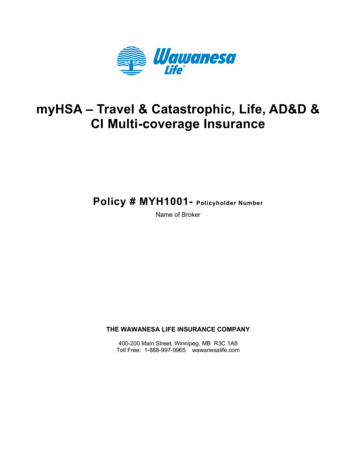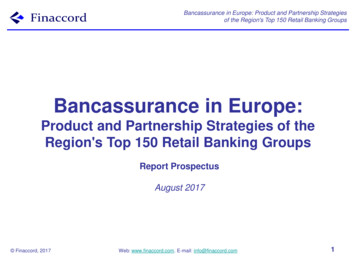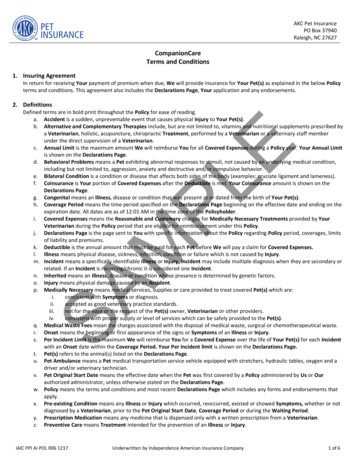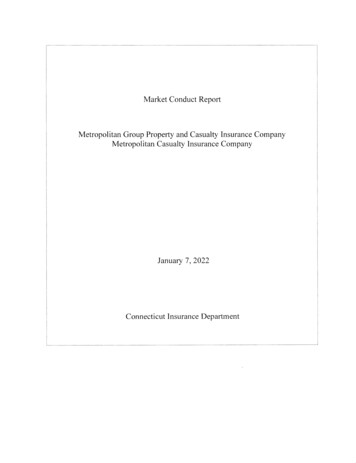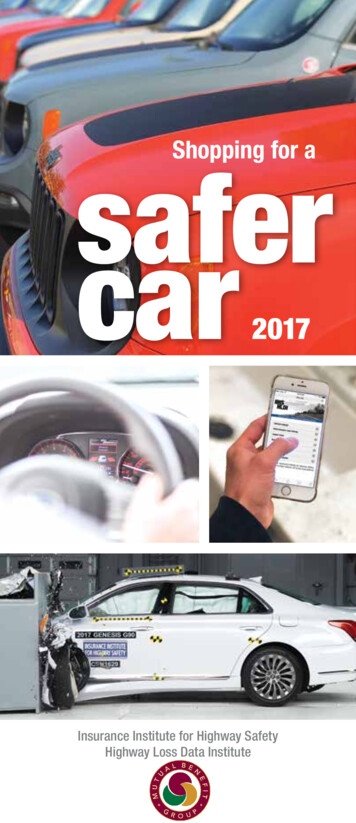
Transcription
Insurance 2.0: Insuring the Sharing Economy &Sharing the Insurance EconomyDion Oryzak and Amit VermaAbstract: The rise of the sharing economy (including firms such as Uber, Airbnb and TaskRabbit) has creatednew insurance challenges as assets traditionally insured under personal lines policies are being used bymicropreneurs to generate income on a part-time, and often full-time, basis. The peer-to-peer nature of theseunique risks is unprecedented as they have only recently been enabled by advances in mobile technology. Theinsurance industry has been extremely cautious about entering this space, even as regulators have increased callsfor a solution bridging the insurance gaps between personal and commercial coverage. We believe this peer-topeer trend will continue and could culminate in true peer-to-peer insurance, or risk transfer between individuals,with regulators constantly playing catch up and insurers either adapting or being displaced. In preparing thispaper we interviewed executives from major players in the sharing economy and the insurance industry.Keywords: sharing; collaborative consumption; ridesharing; homesharing; carsharing; peer-to-peer; peers; Uber;Lyft; Airbnb; Getaround; RelayRides; Lending Club; Farmers Insurance Group; Greenlight Re; James RiverInsurance CompanyINTERVIEWEESIn preparing this paper we interviewed the following people. Joel Laucher, Deputy Commissioner, California Department of Insurance (CDI)Frank Chang, Lead Actuary, UberJohn Clarke, Senior VP Marketing, James River Insurance CompanySam Zaid, CEO and Founder, GetaroundShelby Clark, Executive Director, peers.org, (also Founder and ex-CEO of RelayRides)Dave Cummings, Senior VP Personal Lines, ISOMariel Devesa, Head of Innovation, Farmers Insurance GroupRobert Passmore, Senior Director of Personal Lines Policy, Property Casualty InsurersAssociation of America (PCI)Jim McNichols, Chief Actuarial Officer, Greenlight ReLaura Maxwell, Consultant, Pinnacle Actuarial ResourcesGraeme Adams, Principal, Finity Consulting, Australia (and ex-Head of Product &Underwriting at IAG)Dr. Amy Gibbs, Digital Communications Manager, ANZIIFThe quotes attributed to each interviewee throughout this paper were spoken extemporaneouslyand do not necessarily represent the views of the organization they work for. We thank themimmensely for their time, input and expertise.Casualty Actuarial Society E-Forum, Summer 20151
Insurance 2.0: Insuring the Sharing Economy & Sharing the Insurance EconomyPRESENTATIONThere is a supplementary presentation that will be presented at the CAS Ratemaking & ProductManagement Seminar on March 10, 2015 and can be accessed at the following:https://prezi.com/tktcfvgex fb/insurance-20/INSURING THE SHARING ECONOMYUberrima fides means “utmost good faith” or, more simply, “trust”. Two-way trust lies at theheart of the business models of both the insurance industry and the sharing economy. ‘Trust’uniquely binds the two. When policyholders pay a premium they trust that insurers will honor theirpromise to pay at claim time. Insurers trust that policyholders will truthfully disclose relevantinformation at the time of both underwriting and claim submission. When somebody rents out theirhome for a few days to a stranger using Airbnb, they trust that this stranger will look after theirproperty. When somebody takes a ride downtown courtesy of Uber they trust that the driver will getthem there safely and hassle-free. Both those providing and receiving the peer-to-peer service trustthat the tech-based intermediary that matched them up has policies in place to effectively deal withthings going wrong. Whether such events are tragic accidents or malicious, everyone trusts that therelevant party within the transaction has adequate insurance coverage and that lawmakers haveadequately anticipated these risks and mandated beforehand which party should carry what kinds ofcoverage. Most of the time, this trust is well-placed and this new economy functions seamlessly. Butwhen it does break down, it does so with unfortunate consequences.The “move fast and break things” mantra of Silicon Valley is at odds with the slow and cautiousapproach of the insurance industry. With traditional insurance you know what you’re insuring, whois using it and why. For auto coverage you know the insured’s age, address, vehicle and drivingrecord, and you know if they will be using it for weekend drives or commuting to work. Forhomeowners coverage you know location, construction type, characteristics of the residents and thatthey will be living in the property most of the year. The fine rating details may vary from policy topolicy, but the broad risk profile is consistent both over time and between policies. Even incommercial auto policies you know the fleet of vehicles being insured and possibly the pool ofdrivers, even if you can’t know who will be driving at any point in time.Those assumptions break down in the sharing economy, where individuals act as micropreneurs,switching their assets seamlessly between personal and commercial use. Risk in the sharing economyis somewhat similar to a landlord’s policy or a home business endorsement on a homeowner’s policy,where a traditionally personal lines asset is used for income generation. But even these personal-
Insurance 2.0: Insuring the Sharing Economy & Sharing the Insurance Economycommercial hybrid risk profiles tend to be both standardized in their own right and constant overtime. A rental property remains so throughout the year, with tenants changing at most once or twicea year and with standard risk mitigation measures in place, like reference checking and bondrequirements. The same properties (or vehicles) entering the sharing economy can see personal andcommercial uses being juggled day in, day out. This new breed of mixed use asset is being facilitatedthrough the recent rise of the smartphone app and tech juggernauts acting as brokers that instantlymatch service seekers with service providers.Hundreds of sharing economy startups have launched online in the past six years. The followingare some of the better-known firms: Homesharing: Airbnb; VRBO, HomeAway, Wimdu Transportation Network Companies (TNCs), aka Ridesharing: Uber, Lyft, Sidecar,Hailo Carsharing: RelayRides, Getaround, FlightCar Care: DogVacay.com (dog care), care.com (child care, home care, senior care, pet care) Other: Taskrabbit (odd jobs and errands), SnapGoods (possession sharing), EatWith (diningwith strangers)Businesses like ZipCar and car2go offer essentially by-the-hour rental cars leased from a dedicatedcorporate entity and do not offer truly peer-to-peer services, so aren’t included above.Insuring the sharing (or peer-to-peer) economy requires a unique insurance product design thatbridges personal and commercial insurance, as well as a pricing methodology that is responsive to themix of personal and commercial exposure varying day-to-day or minute-to-minute. The unique riskprofile of using personal assets for peer-to-peer income generation on a large scale, facilitated by atechnological intermediary, gives rise to two different issues. Firstly, an insurance gap arises becausepersonal lines policies generally won’t pay claims if the asset was being used for income generation atthe time a claim is incurred. A separate policy, probably a commercial lines one, would be required,which can be an expensive and onerous requirement for a micropreneur. Secondly, even whereinsurers are prepared to cover these periods of exposure, the question of how to price this coverage istricky. Historical experience is little help as a pricing guide for the new and unique risks presented bythe sharing economy.Unique Risk ProfilesIt is important to isolate the underlying reasons for why the risk exposure for each type of peerto-peer business is different from that of a standard personal lines policy covering the same asset.HomesharingHomesharing services like Airbnb generally create a greater property risk than is priced into a
Insurance 2.0: Insuring the Sharing Economy & Sharing the Insurance Economytraditional homeowner’s policy, resulting in denial of claims arising from or because of a ‘guest’. Theincreased risk mainly arises from having strangers occupy and use the property without the owner’ssupervision. The exact accommodation a guest may rent varies from the entire property to just acouch for the night. Guests may intentionally steal or destroy the property or simply act morecarelessly than they would with their own property.A 2011 incident 1 referred to as ‘Ransackgate’ involved a woman renting out her apartment in SanFrancisco’s Mission district on Airbnb. The guests vandalized the property, burning much of herpossessions to ash, as well as stealing birth certificates, social security numbers and credit cards thatwere kept in a safe on the premises. This prompted Airbnb to create its 50k (now 1m) HostGuarantee and offer it free of charge to hosts in the United States and now several other countries 2.Transportation Network Companies (TNCs)TNCs (or ridesharing companies) involve a taxi-like, or limousine-like, service where driversrespond to requests on their smartphone and transport passengers from one destination to another.The TNCs (such as Uber, Lyft or SideCar) sign on drivers as independent contractors and notemployees of the TNC. The TNC provides the connection infrastructure, payment processing andbranding that drivers rely on to attract passengers.The increased risk for TNC drivers working for companies like Uber, Lyft and Sidecar arises forquite a different reason to that of homesharing. The guests in a TNC service are chauffeured ratherthan left unsupervised, so malicious damage to, or theft from, the vehicle is unlikely to be a problem.The increased auto risk simply arises from being on the road for a longer period of time (andproportional increase in liability and collision risk) when your job involves driving for much longerperiods than would be the case under an equivalent purely personal use vehicle. There is also anincreased risk from travelling through a greater variety of neighborhoods that the driver may not befamiliar with.There are many types of TNC drivers, from those who drive a 40-50 hour-per-week full-time job,to those who opportunistically offer rides occasionally when they happen to be travelling for personalreasons and check their app to see if they can pick up someone travelling in the same direction. Thenature of risk exposure from TNC risks is not qualitatively different from that of a personal linespolicy, only the duration (or distance travelled) for which they are exposed.CarsharingCarsharing services like Getaround and RelayRides involve an individual advertising their car on te/https://www.Airbnb.com/guarantee
Insurance 2.0: Insuring the Sharing Economy & Sharing the Insurance Economysmartphone service, which can then be rented by other individuals on a short term basis. As a crossbetween Transportation Network Companies (without the chauffeur component) and homesharingservices, carsharing services suffer from the problems of both groups. These vehicles are on the roadfor longer than pure personal vehicles are, and they are also in the possession of strangers, who mayact maliciously or more carelessly than the owner would. A high demand vehicle in a city centerlocation could have six different drivers per day.When you rent out your vehicle under RelayRides and Getaround, your personal lines policyceases to be exposed, with the RelayRides and Getaround commercial policy becoming primary witha Combined Single Limit of 1m. The insurance market had never seen this type of exposure before(outside of traditional rental car businesses), so even when insurance is offered it tends to be pricedsomewhat conservatively as if it were a commercial livery policy. More commonly, insurance is notobtainable at all.ErrandsThe business model behind TaskRabbit is that when someone needs a quick errand run (such aspicking up dry cleaning), they will advertise it on the app, with an individual (known as a Tasker) inthe area bidding on it, such as offering to pick up your clothes and deliver them to your house for a 5 fee, while another person/Tasker beats that offer with a 4 bid. On the surface, an errandrunning service seems to have a less problematic business model than Airbnb or Uber. After all, theyaren’t leasing property, nor are they transporting people on public roads. However, if the Tasker isdriving while running an errand, say to pick up your dry cleaning, then the personal lines autoinsurer usually won’t pay, since their vehicle is being used for income generation. Knowing this, it’smuch easier for a TaskRabbit courier to equivocate at claim time, saying they happened to be drivingfor personal use at just that time rather than running someone else’s errand, than it is for an Uberdriver or Airbnb host to similarly claim that damage arose purely from personal use. A larger riskexists for liability and vicarious liability if people/property are damaged during the course of a Taskerperforming an errand.OtherPeer-to-peer possession sharing, like that offered by SnapGoods, is probably the most problematicoffering in the peer-to-peer economy from a risk pricing perspective. If one person lends anotherperson a ladder for a fee and the ladder breaks, who is liable for the resulting damage? How can sucha liability be priced in advance? When faced with the liability risk of one stranger lending anotherstranger any variety of household tools like a ladder, a drill, a corkscrew or a chainsaw in any possiblestate of repair or disrepair, other peer-to-peer arrangements like Airbnb and RelayRides start to lookextremely standardized and predictable by comparison.
Insurance 2.0: Insuring the Sharing Economy & Sharing the Insurance EconomyCurrent Insurance ArrangementsIn one sense, many of the risks presented by the sharing economy have always existed. They havejust been unknown and absorbed into the general risk pool. Joel Laucher (CDI) commented:“It seems so new, and yet we know it has probably been going on for some time, so it’s not brandnew. I think it’s just that size of the enterprise has grown to a point where it has vaulted into view.The exposure’s been there and it has been absorbed without anyone noticing. There haven’t beenany awful consequences that we’ve heard about before the TNC activities hit the news as a result ofaccidents involving fatalities and injuries.”Robert Passmore (PCI) expressed similar sentiments:People have had vacation homes forever and rented them out part of the season and usedthem part of the season. Insurance products have been adapted to them .Like being ahandyman; TaskRabbit is providing a more formal marketplace for something that hasalways been available informally. The risk has always been there. If you’re working as ahandyman there’s a possibility you could make a mistake and something bad could happen. Idon’t think that’s changed. I think they could grow a lot more because of the ease of use ofthe marketplace. The smartphone is just a boon for this kind of stuff. Before you had to hearabout a handyman by word of mouth.In many of these instances, the admitted market won’t even accept the risk, and coverage needs tobe sought from the Excess and Surplus (E&S) market. In most states even accessing the E&S marketfirst requires a licensed agent to conduct a due diligence search from admitted carriers in the state totry and accept the risks. Upon three rejections 3, the agent is allowed to access the E&S market via asurplus lines broker licensed in the state. John Clarke (James River) explains how critical the E&Smarket was to the fledgling sharing economy:The creation of coverage for the TNC industry (ridesharing coverage) is a great example ofthe surplus lines market at work. Last year, as the new industry saw a large amount ofgrowth, they (the ridesharing companies) were deciding to buy, add or endorse coveragerelated to UM, UIM, expanding limits, changing from contingent to primary coverage andmaking all kinds of the other coverage changes. Frankly, you have to have the flexibility ofsurplus lines to keep up with something that’s evolving this fast. We could make changes forthem rapidly. The admitted market just doesn’t have that flexibility, even if they wanted todo so.These exposure types do have precedents from the old economy though. A pizza delivery driverusing their own vehicle wouldn’t be covered by their personal lines policy during work periods, sothe pizza chain’s commercial auto policy could cover these non-owned autos for the specific timesUnless the type of insurance being sought is classified as an exportable item by the state. This does not require the duediligence search to be fulfilled before seeking coverage from the E&S market.3
Insurance 2.0: Insuring the Sharing Economy & Sharing the Insurance Economythey are being used commercially. A landlord’s policy or home business endorsements are otherexisting examples of personal/commercial lines hybrids.Some of the ridesharing companies have an E&S policy covering their drivers whilst they areoperating in a ridesharing capacity with a commercial liability limit typically of 1m. However, upuntil recently they were engaged in a disagreement with admitted insurers in most states on the riskprofiles of their drivers and hence the price of the commercial coverage. TNCs argued that their fulltime and part-time drivers have risk profiles more similar to that of a personal lines risk or a lessactive livery service. Insurers, however, argued that the ridesharing companies’ drivers are moresimilar to taxis, requiring higher premiums than other types of livery, and much, much higher than apersonal auto policy.There have been reports in the news that TNC-related claims are probably still being reported aspersonal auto claims. Joel Laucher (CDI) commented:The personal auto carriers are probably paying some costs that they didn’t account for intheir pricing and are paying for coverage that they think they’ve excluded.Personal auto insurers don’t seem too concerned by the rise of ridesharing, with Joel Laucherfurther referring to conversations with carriers:I was surprised on the ridesharing part, that companies didn’t come in and immediatelystrengthen their exclusions on the livery .No one’s really told us, well our first questionnow during a claims investigation is “Are you driving for a TNC?” They have kind of saidthat they haven’t really changed their practices. It doesn’t really seem prudent, at least inthese areas where you know there is a lot of activity.Laura Maxwell (Pinnacle) reiterated this view:Insurance companies need to start working on their underwriting rules and policy exclusions.I don’t see that happening.The lack of proactivity, initiative or innovation by the insurance industry was a consistent themethat resonated through each interview. Dave Cummings (ISO) elaborates:From my point of view, [the insurance industry] has historically not been at the forefront ofemerging technologies and changing conditions. Many new exposures are initially excludedand the sense of urgency is not immediately recognized. However, over the past few years,we are seeing some insurers addressing these issues differently and embracing change andinnovation. This is a very encouraging trend for the entire industry.The reluctance of carriers to take decisive action can probably be attributed to two things:
Insurance 2.0: Insuring the Sharing Economy & Sharing the Insurance EconomyFirstly, lack of a clear opportunity, with both the small size of the potential premium pool andthe high uncertainty around its size. Joel Laucher (CDI) elaborated on this:TNCs themselves play it pretty close to the vest in terms of how many drivers they have andso there’s kind of a lack of information about how many exposures are out there. Insurersdon’t know how many TNC drivers they have on their books now. And they don’t know ifthere are enough TNC drivers to make it a market that they want to get active in. I guessthey don’t know how much it might grow and if they are going to miss the boat if they don’tget out there. Insurers really want to see something worth their time before they spend muchenergy on it.Laura Maxwell (Pinnacle) made a similar observation about the observed to-date small size of theridesharing opportunity, and by extension the additional risk, in a report for the Colorado DOI:[The report] looked at how many extra miles rideshare drivers are going to drive comparedto how many miles are already in the personal auto system. And they came up with prettymuch none. It is such a small percentage at this time.Secondly, the elephant in the room is simply the difference in culture between the insuranceindustry and the tech startup industry, with Sam Zaid (Getaround) elaborating:I think insurance [culture] is very entrenched and slow moving. That’s sort of the nature ofsomething where you have a lot of risk. If something is risky and you iterate very quickly,odds are you are going to lose that game. If you have something that really works and coversall the risk, it can be scary to go in a new direction. Historically the rate at which industriesformed and shaped has been a lot slower than it is today. Insurance companies are iteratingat that previous pace.In mitigating the risk of stepping into the unknown, the actuarial profession’s default approach isto first amass data. The more data the better, and don’t come back until you’ve got it. DaveCummings (ISO) commented on ridesharing data collection:Personally, I’d love to have as much of the data as possible. The more data we have on therisk the more accurately we can price. There are opportunities in data here which couldenable some very interesting pricing and could respond well to the types of exposures andrisks. This data would be different than the data we traditionally collect. However, it maybe data ridesharing companies are reluctant to share. The fundamental questions we want toanswer regarding risk are; how often a driver is using their vehicle for personal use vs.ridesharing, how many miles are they driving, where are they driving when working andwhen are they driving for the ridesharing company? Understanding if a driver is operating inan urban environment at night versus daytime in a rural setting, gives us an opportunity tothink about and analyze the risk holistically.And on homesharing data collection:
Insurance 2.0: Insuring the Sharing Economy & Sharing the Insurance EconomyI’d like to see more data collection that speaks to the exposure, seeing as how the exposure isa little different that a traditional homeowner or renter exposure. A lot of data is beingcollected by other sources and relates to the home’s usage and exposure. One useful piece ofinformation would be a better understanding of the owner or renter to relate that to otheraspects of the risk. Knowing who is hosting and who is occupying the space during couldbetter define the aspects of risk, specifically to the individuals involved.And touching on setting up a sharing economy central database:A central repository to identify those who are drivers for ridesharing, leasers of homesharing,or participants of carsharing could be beneficial across the entire industry. The individualswill benefit from receiving proper coverage and ensuring there are no gaps in the coverage.Insurers will benefit by better pricing and classifying the risks they choose to write. Creatinga mechanism where insured and insurers are able to communicate openly about coveragewould help ensure coverage exists from the insurer’s side and adequate coverage is receivedby the insured.Mariel Devesa (Farmers Insurance Group) also spoke on the challenges of pricing ridesharing inthe absence of good quality data:Data is key for us to price appropriately. As this is a very new industry, we used availabledata to price. As we learn more, by gathering actual data about our specific drivers and startunderstanding our drivers’ behaviors better, we’ll be able to improve. With more data,everything will get better.A catch-22 arises from the insurance industry’s desire for data as a prerequisite to offeringdedicated insurance products for the sharing economy. This has led to much frustration fromentrepreneurs unable to launch their sharing economy ventures. Shelby Clark (peers.org) recountshis experience in launching RelayRides:When we were trying to launch RelayRides, [one carrier] strung us along for six months andthen they said, ‘We really want to write this policy but we just need some data so why don’tyou come back after six months of operations and we’d be happy to take a look at this.’ Forus, that was really not helpful at all and they should have told us this six months ago. Howare we supposed to get the data if we can’t operate without insurance? We didn’t go back tothem. If you don’t take a chance you lose the business.The RelayRides experience was far from unique. Sam Zaid (Getaround) also detailed thedifficulties he faced securing an insurance arrangement before being able to launch his company’scarsharing business:We talked to agents and brokers. Many of them told us they could help but all they offeredus were off-the-shelf products. We resorted to calling VPs from different insurancecompanies directly—we probably reached out to between 50 and 100 different contacts,
Insurance 2.0: Insuring the Sharing Economy & Sharing the Insurance Economyeither through warm introductions or cold calls. One or two insurers came to the table but,still, we did not get a deal done. That process was probably about 12 months. I guess youcould argue that a car owner’s insurance would apply but that wasn’t proven. Since the carowners themselves weren’t driving, we felt we needed a group insurance solution to protectour community. Once we finally secured insurance, we launched.Other startups haven’t been so cautious, instead preferring to launch anyway, expecting (orhoping) their personal insurance policies would simply cover claims due to ambiguities in policywording that meant, in many cases, sharing economy activities weren’t explicitly excluded. With anindustry that has been very slow to offer specialist coverage, or even tighten up exclusion ambiguitiesin existing personal lines coverage. The only real option for such startups has just been to launch andhope for the best, with the expectation that once enough data is collected, proper insurance solutionswill be developed.In October 2014, five and a half years after Uber was founded, Erie Insurance launched whatthey touted to be a first-of-its kind coverage specifically designed to protect TNC drivers 4. As bestwe can tell from examining the publicly available filings, Erie have taken their personal auto businessuse endorsement, like that used by pizza delivery drivers, and removed the livery exclusion, whilekeeping the existing pricing structure in place. Their flat business use endorsement remains at 12%or 20%, depending on whether the annual number of miles driven is less than or greater than12,500, but is not sensitive to the proportion of the driver’s time that is split between personaldriving and driving for hire.Erie’s effort was followed by Farmers Insurance Group launching a ridesharing specificendorsement to their personal auto policy in Colorado 5. Available from February 2015, the Farmersendorsement extends personal lines coverage to Colorado’s legally required limits when a ridesharingapp is turned on but no passengers have yet been accepted (commonly referred to as Period 1). Theendorsement ceases when a ride has been accepted, as the TNC’s group commercial policy shouldthen become primary. Press releases suggested the endorsement was priced at an average of 25%loading.In early 2012, in response to ‘Ransackgate’, Airbnb started offering a Host Guarantee Policy tohosts living in qualified countries. The Host Guarantee Policy, underwritten by a Lloyds of Londonsyndicate, provides a 1m limit. This only covers deliberate property damage by a guest and does notcover accidental property damage nor liability, applies in excess of any primary policy, applies onlyafter seeking and failing to recover from the malicious guest himself and needs to be reported colorado-drivers-300021370.html45
Insurance 2.0: Insuring the Sharing Economy & Sharing the Insurance Economysooner of 14 days after check out or at the start of the next rental 6. This coverage could beconsidered pretty restrictive and possibly lead to an insurance gap problem. New York lawmakershave picked up on this, urging the State Superintendent in September 2014 to investigate 7.In response to this gap in liability coverage, on 20th November 2014 Airbnb announced theintroduction of Host Protection Insurance 8. Effective 15th January 2015, it will automaticallyprovide 1m liability coverage to hosts within the U.S. in excess of their primary coverage.HomeAway (another homesharing service) offers primary commercial coverage to their membersthrough a program called Assure that they write in partnership with P&C broker CBIZ InsuranceServices.Like Airbnb’s Host Guarantee and Host Protection Insurance, most homesharing coveragedevelopments have been initiated by the homesharing websites themselves. Insurers have been slowerto address homesharing coverage gaps than they have been for ridesharing. Joel Laucher (CDI)commented:There’s a big difference between homesharing and ridesharing. I think it’s fair to assume thatthe insurers’ intent was to not cove
Insurance Company _ INTERVIEWEES . In preparing this paper we interviewed the following people. Joel Laucher, Deputy Commissioner, California Department of Insurance (CDI) . For auto coverage you know the insured's age, address, vehicle and driving . as well as a pricing methodology that is responsive to the mix of personal and .





